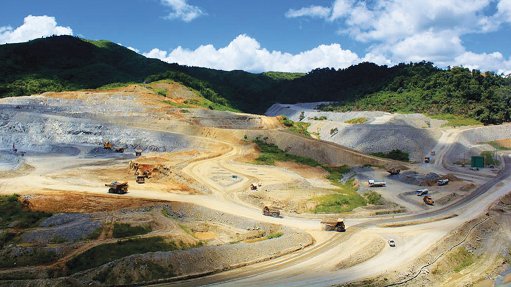
Name: Didipio mine.
Location: The Didipio mine is located in Luzon, about 270 km north of Manila, in the Philippines.
Controlling Company: OceanaGold.
Brief History: OceanaGold acquired the Didipio mine through the merger with Climax Mining in November 2006. A local partner is entitled to a free carried interest of 8% in the operating vehicle of the mine. In June 2011, OceanaGold restarted construction of the high-grade Didipio gold/copper mine. Construction of the mine and the mineral processing facility to the north of the openpit was completed in the fourth quarter of 2012. Following successful construction and commissioning, OceanaGold declared commercial production at the mine on April 1, 2013.
Brief Description: Didipio is an openpit/underground gold/copper operation, with an estimated mine life to 2030.
Products: Gold/copper.
Geology/Mineralisation: Chalcopyrite, a sulphide mineral of copper and iron, and gold are the main economic minerals in the Didipio deposit. Chalcopyrite occurs as fine-grained disseminations, aggregates, fracture fillings and stockwork veins, particularly in the vein zone of alteration. Some bornite, also a sulphide mineral of copper and iron, is also present.
The orebody contains a higher concentration of copper near surface and, hence, copper production in the early years is expected to be higher than the average life-of-mine production and lower in the later years.
Reserves: Total proven and probable reserves as at December 31, 2013, were estimated at 45.65-million tonnes grading 1.09 g/t of gold.
Resources: Total measured and indicated resources as at December 31, 2013, were estimated at 61-million tonnes grading 1.05 g/t of gold. Inferred resources were 14.7-million tonnes grading 0.6 g/t of gold.
Mining Method: Openpit and underground. The openpit mine is expected to operate on its own for the first four years of opera- tion, with the underground development currently planned to start with minimal ore in years 5 to 7. Openpit and underground activities will run concurrently until the pit is completed in Year 12, with final low-grade ore stockpiles from openpit mining to be milled at the conclusion of the openpit and underground operations.
Major Infrastructure and Equipment: Ore is processed using a conventional semiautogenous/ball mill grinding circuit followed by froth flotation for the recovery of copper/gold concentrate. A gravity circuit is incorporated in the grinding circuit to produce gold bullion on site. Concentrate is transported by road to existing port facilities for export.
Prospects: In the quarter ended March 31, OceanaGold started with the development of the underground decline at Didipio and continued to advance the power grid connection.
Contact Person: Media relations, Andrea Atell.
Contact Details:
tel +61 3 9656 5300,
fax +61 3 9656 5333,
email info@oceanagold.com, and
website http://www.oceanagold.com.